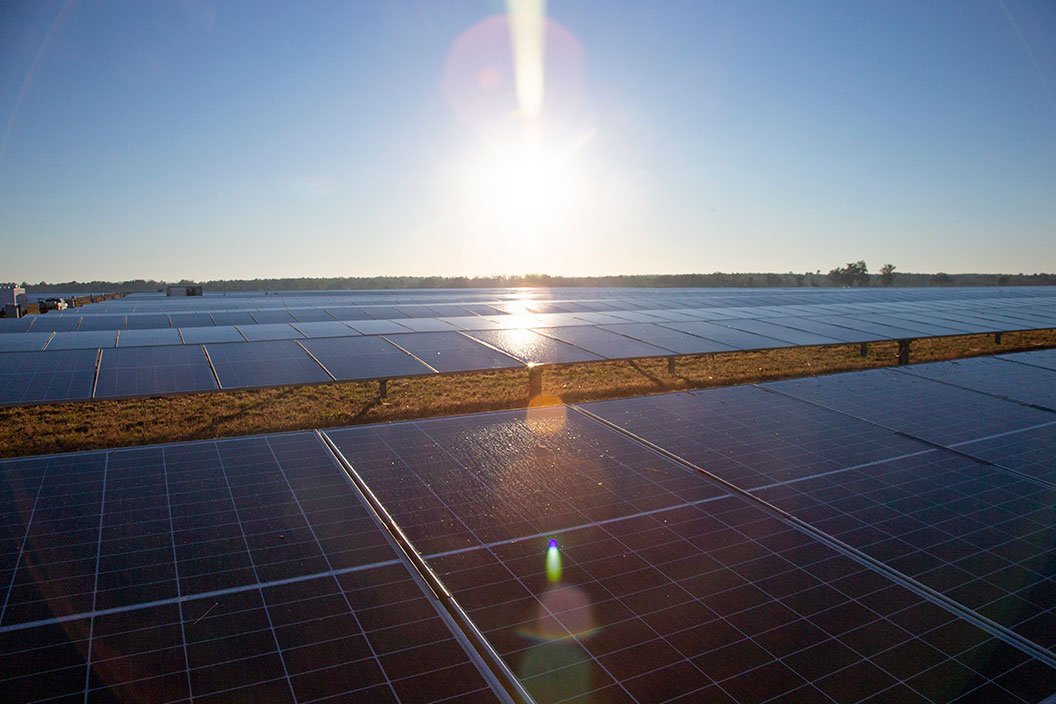Solar Power Purchase Agreement: A Milestone for Carbon Neutrality

Sebree Solar II, set to begin construction in early 2025 and commence commercial operation by the end of 2026, will resemble NextEra's Cool Springs Solar Energy Center (above).
Swarthmore is joining forces with eight other colleges and universities in North Carolina and Pennsylvania to bring a large-scale solar facility online in western Kentucky, called Sebree Solar II. By collaborating on this Power Purchase Agreement (PPA) with Davidson College, Dickinson College, Elon University, Haverford College, Lafayette College, Lehigh University, Muhlenberg College, and Wake Forest University, Swarthmore is accessing the benefits of renewable energy through a deal typically only feasible for large customers.
"I am so pleased that the College has been able to bring this five-year effort to build large-scale renewable energy generation to an actual project with such a highly esteemed partner group who share Swarthmore College's decarbonization goals," says Associate Vice President for Sustainable Facilities Operations and Capital Planning Andy Feick.
The PPA is a critical piece of To Zero By Thirty-Five (20X35), the College’s transformative plan to achieve carbon neutrality by 2035. Through this agreement, Swarthmore will eliminate 100% of its current annual greenhouse gas emissions associated with purchased electricity, which accounts for approximately one-third of its total emissions inventory. This is an important step towards decarbonizing Swarthmore’s campus energy systems as it transitions to geoexchange for heating and cooling. By coupling geoexchange with renewable energy, 20X35 will eventually eliminate up to 98% of campus greenhouse gas emissions related to energy and purchased electricity.
Kyle Richmond-Crosset ’19, a fellow of the 2018-19 President's Sustainability Research Fellowship (PSRF), began the process for this PPA. Richmond-Crosset’s PSRF project focused on exploring available renewable energy options to help the College chart a pathway towards procurement. He found that an aggregated PPA, where schools collaboratively purchase off-site renewable energy, was the best path forward for the College.
Director of Sustainability Elizabeth Drake, explains, “Richmond-Crosset’s PSRF project coming full circle exemplifies how the program creates learning opportunities for students that results in real, long-lasting change at the College.”
In addition to acquiring off-site renewable energy, the College will continue to explore opportunities to expand solar installations on campus, such as the 400-kW-capacity solar array on the top of the Dining and Community Commons.
Guided by Coho, an ERM Group Company, the institutions are working with NextEra Energy Resources, the world’s largest generator of renewable energy from the wind and sun, and a world leader in battery energy storage. The consortium is supporting the Sebree Solar II project through a PPA that entails purchasing energy for 20 years. The Sebree Solar II project is set to begin construction in early 2025 and commence commercial operation by the end of 2026. The solar site is projected to provide enough energy to annually power more than 24,000 homes when complete.
The solar facility will be located near the town of Robards, Ky., near the Ohio River. The Sebree Solar II project will offer considerable environmental benefits as the project will generate up to 150 megawatts of clean, renewable energy. Over its 30-year lifespan, the solar site will contribute approximately $12 million in additional tax revenue to Henderson County which can be used for roads, schools and other public services.
While electricity generated by the Sebree Solar II project cannot be transmitted directly to the consortium campuses because of distance, the benefits of investing in new additional renewable energy will still be transferred to the schools. Swarthmore will be paying for an amount of energy equal to 100 percent of the electricity currently used by its campus. In exchange, the College will receive renewable energy credits, which can be used to account for greenhouse gas emissions related to purchased electricity.
The institutions in the cohort will also receive access to data from the Sebree Solar II project for classroom use, as well as campus speaking engagements, site visits, and student internships.


